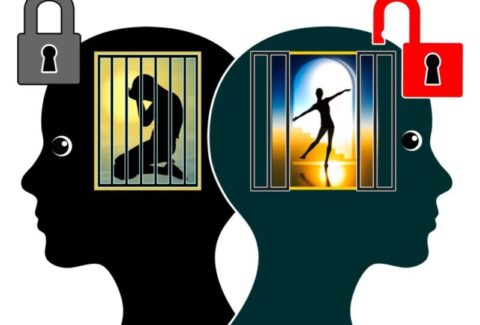The 20 Clinically Relevant Schemas
In the intricate landscape of the human psyche, schemas[1] weave the threads of our core beliefs, influencing thoughts, feelings, and behaviors. Rooted in our early experiences, these enduring patterns shape the lens through which we perceive ourselves and the world. As we embark on this exploration, we uncover the 20 clinically relevant schemas, each a distinct color in the tapestry of our minds.
- Abandonment/Instability:
The Echo of Unseen Fears: A haunting fear of being left alone, a constant companion in the silence of potential abandonment.[2]
- Mistrust/Abuse[3]:
The Shadows of Betrayal: Lingering suspicions, an expectation that others bear the potential to inflict harm, exploiting trust.
- Emotional Deprivation:
The Hollow Echo of Loneliness: A pervasive sense of emptiness, a belief that emotional needs[4] will forever go unanswered.
- Defectiveness/Shame[5]:
The Shadow of Perceived Flaws: The relentless whispers of inadequacy, an internalized shame that paints every success with doubt.
- Social Isolation/Alienation:
The Dance of Isolation: A delicate waltz with feeling different, a yearning for connection overshadowed by the fear of not fitting in.[6]
- Dependence/Incompetence:
The Weight of Reliance: An ever-present burden, the belief that one cannot navigate life’s challenges independently.[7]
- Vulnerability to Harm[8] or Illness:
The Ominous Symphony: A crescendo of fear, an anticipation of impending doom that echoes through the corridors of the mind.
- Enmeshment/Undeveloped Self:
The Dance of Blurred Boundaries: A struggle to distinguish where one ends and another begins, an elusive quest for a separate identity.
- Failure:
The Unforgiving Mirror: A reflection tainted by self-doubt, the anticipation of personal failure regardless of actual achievements. - Entitlement/Grandiosity:
The Throne of Self-Importance[9]: An inflated self-image, an entitlement that obscures the view of others. - Insufficient Self-Control/Self-Discipline:
The Battle of Impulses: A struggle for self-mastery, a conflict between desires and the restraint demanded by societal norms. - Approval-Seeking/Recognition-Seeking:
The Thirst for Validation: A relentless pursuit of external approval, a yearning to be seen and recognized. - Negativity/Pessimism:
The Shadow of Despair: A default setting tuned to negativity, a lens that perceives life through the hues of pessimism[10]. - Emotional Inhibition:
The Veiled Expression: A cloak concealing genuine emotions, a fear of vulnerability that stifles authentic expression. - Unrelenting Standards/Hypercriticalness:
The Unattainable Summit: A quest for perfection, a relentless climb up standards that perpetually exceed reach. - Punitiveness:
The Harsh Judge Within: A stern inner critic, a tendency to administer punishment, often more severe than warranted. - Subjugation:
The Chains of Sacrifice: A surrender of personal needs, an enslavement to the desires and expectations of others. - Self-Sacrifice[11]:
The Paradox of Giving: A sacrifice of self for the well-being of others, a fine line between altruism and personal depletion. - Approval-Seeking/Recognition-Seeking:
The Echoing Desire: A persistent seeking of approval and recognition, a hunger that echoes through interpersonal interactions. - Abuse:
The Haunting Echo of Trauma: A pervasive impact of abuse, a distorted lens through which the world is perceived, shaped by experiences of emotional, physical, or sexual harm.
In the therapeutic journey, understanding these clinically relevant schemas becomes the compass that guides individuals toward self-discovery and healing. Each schema, a chapter in the narrative of the mind, unveils opportunities for growth, resilience, and the reweaving of the tapestry into a more vibrant and empowered existence. As we navigate the complexities of these schemas, let us embrace the transformative power of self-awareness and compassionate intervention, illuminating the path toward mental well-being and resilience.
Schema Therapy[12] offers a solution where Cognitive Behavioral Therapy may have fallen short. It integrates various evidence-based practices, including attachment theory, psychodynamic psychotherapy, mindfulness, and Gestalt therapy. This holistic approach blends the best of each method to engage clients effectively.
[1] Dozois, David JA, and Aaron T. Beck. “Cognitive schemas, beliefs and assumptions.” Risk factors in depression (2008): 119-143.
[2] Jafari Harandi, Reza. “The Role of Abandonment Schema, Self–Other Overlap, and Negative Emotions in Predicting Marital Conflict.” Journal of Couple & Relationship Therapy 20.4 (2021): 405-421.
[3] Jovev, Martina, and Henry J. Jackson. “Early maladaptive schemas in personality disordered individuals.” Journal of personality disorders 18.5 (2004): 467-478.
[4] Hatami, Mohammad, and Maryam Omidbeygi. “Relationship between attachment styles and emotional schemes in adolescents deprived of parental.” Journal of psychologicalscience 14.55 (2015): 342-357.
[5] Asmari, Yousef, et al. “Early negative memories, humiliation and defectiveness/shame schema: An emotion-focused therapeutic approach to social anxiety.” Journal of Evidence-Based Psychotherapies 22.1 (2022).
[6] Abedi, Ali, Mohammad Ali Sepahvandi, and Fazlolah Mirderikvand. “Loneliness and early maladaptive schemas in farhangian university students.” Research in Teacher Education (RTE) 3.1 (2020): 109-125.
[7] Fouladi, Mahdie. “Prediction of depression through early maladaptive schemas.” Mediterranean Journal of Social Sciences 6.1 (2015): 602-611.
[8] Bamber, Martin, and Rachel McMahon. “Danger—Early maladaptive schemas at work!: The role of early maladaptive schemas in career choice and the development of occupational stress in health workers.” Clinical Psychology & Psychotherapy: An International Journal of Theory & Practice 15.2 (2008): 96-112.
[9] Láng, András. “Machiavellianism and early maladaptive schemas in adolescents.” Personality and Individual Differences 87 (2015): 162-165.
[10] Trincas, Roberta, et al. “Specific dysphoric symptoms are predicted by early maladaptive schemas.” The scientific world journal 2014 (2014).
[11] Baroncelli, Cristina Maria Clementina, et al. “The Role of Enmeshment and Undeveloped Self, Subjugation and Self-Sacrifice in Childhood Trauma and Attachment Related Problems: The Relationship with Self-Concept Clarity.” Available at SSRN 4833063.
[12] Young, Jeffrey E., Janet S. Klosko, and Marjorie E. Weishaar. “Schema therapy.” New York: Guilford 254 (2003): 653-658.







